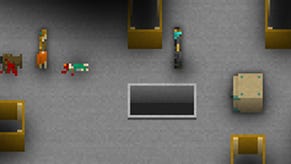Impressions, Part 2: Jason Rohrer's The Castle Doctrine
Fatalist Dungeon Keeper
Right then. Now I've had a little catharsis by revealing how home invasion-themed MMO The Castle Doctrine made me feel, I want to talk a little more about its mechanics.
There are two major 'game' aspects to it. One is building your home and its defences - though the two are part and parcel - and the other is trying to make your way around rival players' DIY fortresses. I appreciate that some people have taken issue with the concept of the game essentially requiring you to be a thief as well as a victim. There's something in that, even despite an option to vote with your feet and simply try to construct the best defences you can. At the same time, I don't see a lot of worry that Planetside 2 or League of Legends requires each team to murder each other, or protest that World of Warcraft contains PvP. But of course, as in the case of the similarly discomfort-inciting Prison Architect, The Castle Doctrine uses real world (or something very close to it) themes rather than fantastical ones.
So I can see the dilemma, but speaking personally I do see Castle Doctrine as an overtly game-like setup rather than a believable one. As such, I'd rather concentrate on the systems within it.
Money is the game's key, and arguably only (depending on what we want to categorise family members as) resource. It's needed both to construct your house and the deadly Home Alone contraptions within it, and to buy the tools - saws, wire cutters, guns - you'll need in the event you decide to steal into someone else's house. Money itself is obtained only by robbing others, or alternatively you can sell the tools dropped in your home by anyone who's killed in the process of trying to rob it.
(With, as I observed yesterday, this closed, early version of the game's player base being so small, I'm necessarily talking more conceptually than from experience here. But I can totally see, from hands-on experience of the game's mechanics and economy, how it would work - this isn't just a line I've been sold.)
In terms of house design, we’re looking at a large, open rectangle into which you may place around a dozen different types of object - walls, doors, windows, pits, dogs (and cats!) and, ultimately most importantly, assorted wiring and switches. It’s a minimalist interface, just a small grid of tiles to choose from which are then simply click’n’placed in the house, and it takes no time at all to build rooms and basic traps. I must admit that, as a helplessly left-brain sort of human, the electronics side of things hasn’t come entirely naturally to me despite hardly being rocket science. I can set up a floor-mounted pressure switch which, when walked over, activates or deactivates a powered trapdoor, but that’s about it.
Still, I was quite proud - any invader would have to follow a circuitous route around the perimeter of my house, taking a gamble on which door-shielded corridors held guard dogs behind them, in search of the one passage which held the switch. They’d then need to walk over that and re-trace their steps back to the entrance in order that they might cross the now-closed trapdoor right by the front door. Caution would realistically be enough to survive this setup - walk one tile at a time, so even though you can’t see more than a few feet around you, you should have enough time to steer away from an electric floor or even flee from a ravenous hound. If someone was as lazy and impatient as I tended to be in others’ houses though, they wouldn’t last seconds.
Or they could just stock up on saws and make their own route through my cheap wooden walls. Bah.
More money buys better walls, which require welders or explosives to pass through, but that doesn’t mean well-guarded, rich houses are off-limits to new or poor players. The great leveller in the Castle Doctrine, and probably its smartest idea, is that every addition or change to your defences requires that you yourself prove the deadly house-maze can be ‘solved’ without the aid of any tools before it will go live to the server. Should you fail to do this, not only will you be denied the sinister pleasure of seeing endless rivals shed their blood on your floor, but you will be dead. Everything you owned and built will be lost, forever.
This creates a remarkable, intrinsic risk-reward dilemma. Sure, you can build something overwhelmingly fiendish, but you’re risking everything if you do. My advice - take careful notes, draw maps, take screenshots, test and test before you commit. The setup I described earlier, with the pressure switch? After adding an extra hound-holding corridor, bought with the spoils of a successful robbery, I became complacent, convinced I knew my own design inside out. En route to the switch, I turned one door too soon. Man’s best friend? Don’t make me laugh. Because I can’t. Because I don’t have a throat to laugh from anymore.
That risk reward concept obviously spreads to the PvP aspect of the game (not that you’ll ever directly encounter other players - robberies can only happen while you’re offline, as far as I can tell), wherein you pick a target from a scoreboard of player worth. Hitting the house whose vault holds the most cash promises a big payday, but chances are the reason it’s got so much money is that everyone else who’s tried to rob it was killed in the process. Are you the God Of Burglary? Better hope so. I suspect the best thieves will have a sort of Matrix-vision which enables them to deduct layouts and maze-navigation without the aid of any tools, but mere humans will likely employ a few aids.
Wire cutters are potentially the most useful, as they can be used to snip the cables between power supplies and electric floors, pressure switches and the like, but this can also lead to logic-sustaining backfires. The apparently bugged, impassable house I mentioned encountering yesterday? Not the case. Well, it was indeed impassable, having as it did an open trapdoor between the front door and the rest of the house, but it wasn’t bugged. In fact, it was Rohrer’s own house, it transpired. The canny blighter, eh? This also means he must have had a giggle or two at my expense, when he returned to the game and watched the Security Tapes (i.e. replays) of my multiple failed attempts to cross or deactivate that trapdoor, each time resulting either my in grumpily giving up and going home or simply striding into the pit and hoping for a miracle. The shame of it all.
But if it this house design was truly impassable, how was he able to set it live in the game? Let me share his explanation with you. “It is possible for a house to become impassable after someone else robs it once. Pitbulls move around, switches get tripped, wires get cut. Thus, it is possible to so design your house that it can only be robbed once, if you're really clever.”
In this case, “Someone cut the wires to my first trap door when they robbed my house. Thus, by the time you approached it, it was indeed impassable.” This sounds as though the game is rigged, that the smartest players will get richer and richer, immune to robbery. Again, not so. “I can't visit and leave my own house without again fixing it up and proving that it's passable. It only remains impassable forever if I stay away from the game forever.”
Game, set, match. With no winner. Fascinating.
Thus, all moral and socio-political issues around the game aside, what it’s going to live and die on is the use and abuse of its trap systems, a constant arms race to devise strategies and counter-strategies to stay alive forever in a world which will kill you in a heartbeat. Who can discover the secret to eternal life in this game about death?
The Castle Doctrine will be out soon.











